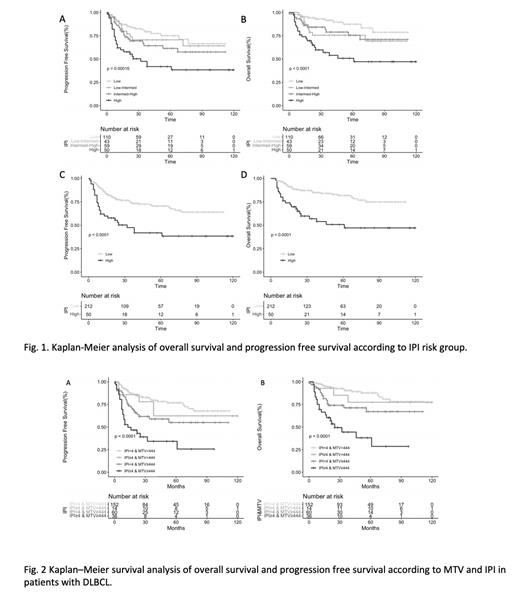Background: In the rituximab era, the international prognostic index (IPI) risk stratification was not enough to predict outcome in patients with diffuse large B cell lymphoma (DLBCL). Previous studies showed the Metabolic tumor volume(MTV) from baseline [ 18F]FDG PET/CT could be used to predict outcome. In this study, we evaluated the prognostic value of IPI and MTV in DLBCL patients.
Patients and methods: A total of 262 de novo DLBCL patients who were treated with the R-like chemotherapy were retrospectively analyzed in this study. The IPI and MTV were compared to the Overall Survival (OS) and Progression Free Survival (PFS).
Results: The MTV is better than TLG and SUVmax for predicting disease progression. The cutoff value of MTV was 444 cm 3. Patients with high MTV showed inferior OS and PFS ( p < 0.001, respectively). Although the IPI remains predictive it distinguishes only 2 risk groups, rather than the 4 groups originally described. Further analysis showed high MTV could identify a subgroup of patients with extremely inferior OS and PFS in high IPI risk patients ( p = 0.0089 and p= 0.024, respectively). Multivariate analysis revealed that high MTV is a significant poor prognostic factor for both OS (HR 3.168[1.81-5.56], p <0.001) and PFS (HR 2.637 [1.51-3.71], p <0.001).
Conclusions: Our study suggests that MTV from baseline PET/CT is an important prognostic factor in DLBCL patients, allowing the identification of an inferior outcome subgroup in high-risk patients, which may help to guide treatment in clinical trial.
Disclosures
No relevant conflicts of interest to declare.


This feature is available to Subscribers Only
Sign In or Create an Account Close Modal